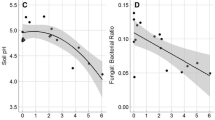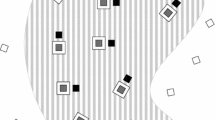Abstract
In situ decomposition of above and belowground plant biomass of the native grass species Andropogon glomeratus (Walt.) B.S.P. and exotic Imperata cylindrica (L.) Beauv. (cogongrass) was investigated using litter bags over the course of a 12 month period. The above and belowground biomass of the invasive I. cylindrica always decomposed faster than that of the native A. glomeratus. Also, belowground biomass of both species decomposed at a consistently faster rate when placed within an invaded area consisting of a monotypic stand of I. cylindrica as opposed to within a native plant assemblage. However, there was no similar such trend observed in the aboveground plant material. The microbial communities associated with the invaded sites often differed from those found in the native vegetation and provide a possible causal mechanism by which to explain the observed differences in decomposition rates. The microbial communities differed not only compositionally, as indicated by ordination analyses, but also functionally with respect to enzymatic activity essential to the decomposition process. This study supports the growing consensus that invasive plant species alter normal ecological processes and highlights a possible mechanism (alteration of microbial assemblages) by which I. cylindrica may alter an ecosystem process (decomposition).






Similar content being viewed by others
References
Aerts R (1997) Climate, leaf litter chemistry and leaf litter decomposition in terrestrial ecosystems: a triangular relationship. Oikos 79:439–449. doi:10.2307/3546886
Allison SD, Vitousek PM (2004) Rapid nutrient cycling in leaf litter from invasive plants in Hawaii. Oecologia 141:612–619. doi:10.1007/s00442-004-1679-z
Ashton IW, Hyatt LA, Howe KM, Gurevitch J, Lerdau MT (2005) Invasive species accelerate decomposition and litter nitrogen loss in a mixed deciduous forest. Ecol Appl 15:1263–1272. doi:10.1890/04-0741
Bradford MA, Jones TH, Bardgett RD, Black HIJ, Boag B, Bonkowski M et al (2002) Impacts of soil faunal community composition on model grassland ecosystems. Science 298:615–618. doi:10.1126/science.1075805
Brooks ML, D’Antonio CM, Richardson DM, DiTomaso JM, Grace JB, Hobbs RJ et al (2004) Effects of invasive alien plants on fire regimes. Bioscience 54:677–688. doi:10.1641/0006-3568(2004)054[0677:EOIAPO]2.0.CO;2
Clarke KR, Somerfield PJ, Chapman MG (2006) On resemblance measures for ecological studies, including taxonomic dissimilarities and a zero-adjusted Bray–Curtis coefficient for denuded assemblages. J Exp Mar Biol Ecol 330:55–80. doi:10.1016/j.jembe.2005.12.017
Dwass M (1957) Modified randomization tests for non-parametric hypotheses. Ann Math Stat 28:181–187. doi:10.1214/aoms/1177707045
Ehrenfeld JG (2003) Effects of exotic plant invasions on soil nutrient cycling processes. Ecosystems (NY, Print) 6:503–523. doi:10.1007/s10021-002-0151-3
Fisher RA (1935) The design of experiments. Hafner, New York
Gardes M, Bruns TD (1993) ITS primers with enhanced specificity basidiomycetes-application to the identification of mycorrhizae and rusts. Mol Ecol 2:113–118. doi:10.1111/j.1365-294X.1993.tb00005.x
Gordon DR (1998) Effects of invasive, non-indigenous plant species on ecosystem processes: lessons from Florida. Ecol Appl 8:975–989. doi:10.1890/1051-0761(1998)008[0975:EOINIP]2.0.CO;2
Grime JP, Mackey JM, Miller SH, Read DJ (1987) Floristic diversity in a model system using experimental microcosm. Nature 328:420–422. doi:10.1038/328420a0
Hawkes CV, Wren IF, Herman DJ, Firestone MK (2005) Plant invasion alters nitrogen cycling by modifying soil microbial communities. Ecol Lett 8:976–985. doi:10.1111/j.1461-0248.2005.00802.x
Hawkes CV, Belnap J, Antonio CD, Firestone MK (2006) Arbuscular mycorrhizal assemblages in native plant roots change in the presence of invasive exotic grasses. Plant Soil 281:369–380. doi:10.1007/s11104-005-4826-3
Hobbie SE (1996) Temperature and plant species control over litter decomposition in a Alaskan tundra. Ecol Monogr 66:503–522. doi:10.2307/2963492
Hobbie SE, Vitousek PM (2000) Nutrient limitation of decomposition in Hawaiian forests. Ecology 81:1867–1877
Holly DC, Ervin GN (2006) Characterization and quantitative assessment of interspecific and intraspecific penetration of belowground vegetation by cogongrass (Imperata cylindrica (L.) Beauv.) rhizomes. Weed Biol Manage 6:120–123. doi:10.1111/j.1445-6664.2006.00198.x
Jackson CR, Vallaire SC (2007) Microbial activity and decomposition of fine particulate organic matter in a Louisiana cypress swamp. J North Am Benthol Soc 26:742–752. doi:10.1899/07-020R1.1
Jackson CR, Langner HW, Donahoe-Christiansen J, Inskeep WP, McDermott TR (2001) Molecular analysis of microbial community structure in an arsenite-oxidizing acidic thermal spring. Environ Microbiol 3:532–542. doi:10.1046/j.1462-2920.2001.00221.x
Jackson EF, Echlin HL, Jackson CR (2006) Changes in the phyllosphere community of the resurrection fern, Polypodium polypodioides, associated with rainfall and wetting. FEMS Microbiol Ecol 58:236–246. doi:10.1111/j.1574-6941.2006.00152.x
Johnson D, Vandenkoornhuyse PJ, Leake JR, Gilbert R, Booth RE, Grime JP et al (2003) Plant communities affect Arbuscular mycorrhizal fungal diversity and community composition in grassland microcosms. New Phytol 161:503–515. doi:10.1046/j.1469-8137.2003.00938.x
Kirker GT (2008) Effects of chlorothalonil (CTN) and butylated hydroxytoluene (BHT) on microbial communities involved in the deterioration of wood using terminal restriction fragment length polymorphism (T-RFLP) analysis. Doctoral Dissertation, Mississippi State University, 160 pp
Klironomos JN (2003) Variation in plant response to native and exotic Arbuscular mycorrhizal fungi. Ecology 84:2292–2301. doi:10.1890/02-0413
Kourtev PS, Ehrenfeld JG, Häggblom M (2002) Exotic plant species alter the microbial community structure and function in the soil. Ecology 83:3152–3166
Lavergne C, Rameau J, Figier J (1999) The invasive woody weed Ligustrum robustum subsp. walkeri threatens native forests on La Reunion. Biol Invasions 1:377–392. doi:10.1023/A:1010001529227
Liao C, Peng R, Luo Y, Zhou X, Wu X, Fang C et al (2008) Altered ecosystem carbon and nitrogen cycles by plant invasion: a meta-analysis. New Phytol 177:706–714
Lippincott CL (2000) Effects of I. cylindrical (cogongrass) invasions on fire regimes in Florida sandhill. Nat Areas J 20:140–149
Liu WT, Marsh TL, Cheng H, Forney LJ (1997) Characterization of microbial diversity by determining terminal restriction fragment length polymorphisms of genes encoding 16S rRNA. Appl Environ Microbiol 63:4516–4522
MacDonald GE (2004) Cogongrass (Imperata cylindrica)—biology, ecology, and management. Crit Rev Plant Sci 23:367–380. doi:10.1080/07352680490505114
Machery-Nagel (2004a) Total DNA purification from plant: user manual for Nucleospin® DNA Plant Kit Rev 3. Machery Nagel. Duren, Germany
Machery-Nagel (2004b) PCR clean-up gel extraction. User manual for Nucleospin® Extract II. Rev 01. Machery Nagel. Duren, Germany
Mack M, D’Antonio CM (1998) Impacts of biological invasions on disturbance regimes. Trends Ecol Evol 13:195–198. doi:10.1016/S0169-5347(97)01286-X
Martin PH (1999) Norway maple (Acer platanoides) invasion of a natural forest stand: understory consequences and regeneration pattern. Biol Invasions 1:215–222. doi:10.1023/A:1010084421858
McCune B, Grace JB (2002) Analysis of ecological communities. MjM Software Design, Gleneden Beach, Oregon
Meentemeyer V (1978) Macroclimate and lignin control of hardwood leaf litter decomposition dynamics. Ecology 59:465–472. doi:10.2307/1936576
Muyzer G, Waal ECD, Uitterlinden AG (1993) Profiling of complex microbial populations by denaturing gradient gel electrophoresis analysis of polymerase chain reaction-amplified genes coding for 16S rRNA. Appl Environ Microbiol 59:695–700
Pereira AP, Graca MAS, Molles M (1998) Leaf litter decomposition in relation to litter physio-chemical properties, fungal biomass, arthropod colonization, and geographical origin of plant species. Pedobiologia (Jena) 42:316–327
Pitman EJG (1937) Significance tests which may be applied to samples from any population. J Roy Stat Soc Suppl 4:119–130 and 225–232 (parts I and II)
Pitman EJG (1938) Significance tests which may be applied to samples from any population. Part III. The analysis of variance test. Biometrika 29:322–335
Requena N, Jimenez I, Toro M, Barea JM (1997) Interactions between plant-growth-promoting rhizobacteria (PGPR), Arbuscular mycorrhizal fungi and Rhizobium spp. in the rhizosphere of Anthyllis cytisoides, a model legume for revegetation in mediterranean semi-arid ecosystems. New Phytol 136:667–677. doi:10.1046/j.1469-8137.1997.00786.x
Rillig MC (2004) Arbuscular mycorrhizae and terrestrial ecosystem processes. Ecol Lett 7:740–754. doi:10.1111/j.1461-0248.2004.00620.x
Shilling DG, Bewick TA, Gaffney JF, McDonald SK, Chase CA, Johnson ERRL (1997) Ecology, physiology, and management of cogongrass (Imperata cylindrica). Final Report. Florida Institute of Phosphate Research. Institute of Food and Agricultural Sciences, University of Florida, Gainesville, FL
Swift MJ, Heal OW, Anderson JM (1979) Decomposition in terrestrial ecosystems. Blackwell, Oxford
Tabor P (1949) Cogongrass, Imperata cylindrica (L.) Beauv., in the southeastern United States. Agron J 41:270
Thies JE (2007) Soil microbial community analysis using terminal restriction fragment length polymorphisms. Soil Sci Soc Am J 71:579–591. doi:10.2136/sssaj2006.0318
van der Heijden MGA, Klironomos JN, Ursic M, Moutoglis P, Streitwolf-Engel R, Boller T et al (1998) Mycorrhizal fungal diversity determines plant biodiversity, ecosystem variability and productivity. Nature 396:69–72. doi:10.1038/23932
Vitousek PM, Walker LR (1989) Biological invasion by Myrica faya in Hawaii: plant demography, nitrogen fixation and ecosystem effects. Ecol Monogr 59:247–265. doi:10.2307/1942601
Vitousek PM, Walker L, Whiteaker L, Mueller-Dombois D, Matson P (1987) Biological invasion by Myrica faya alters ecosystem development in Hawaii. Science 238:802–804. doi:10.1126/science.238.4828.802
Wardle DA (2002) Communities and ecosystems: linking the aboveground and belowground components. Princeton University Press, Princeton
Wedin DA, Tilman D (1990) Species effects on nitrogen cycling: a test with perennial grasses. Oecologia 84:433–441
Westover KM, Kennedy AC, Kelley SE (1997) Patterns of rhizosphere microbial community structure associated with co-occurring plant species. J Ecol 85:863–873. doi:10.2307/2960607
White TJ, Bruns T, Lee S, Taylor J (1990) Amplification and direct sequencing of fungal ribosomal RNA genes for phylogenetics. In: Innis MA, Gelfand DH, Sninsky JJ, White TJ (eds) PCR protocols: a guide to methods and applications. Academic Press, San Diego, pp 315–322
Whitney GG (1991) Relation of plant species to substrate, landscape position, and aspect in north central Massachusetts. Can J For Res 21:1245–1252. doi:10.1139/x91-173
Wilcut JW, Truelove B, Davis DE, Williams JC (1988) Temperature factors limiting the spread of cogongrass (Imperata cylindrica) and torpedograss (Panicum repens). Weed Sci 36:49–55
Windham L, Ehrenfeld JG (2003) Net impact of a plant invasion on nitrogen-cycling processes within a brackish tidal marsh. Ecol Appl 13:883–896. doi:10.1890/02-5005
Acknowledgments
We appreciate being granted access to the Nature Conservancy’s Deaton Reserve where the field component of this work took place and to Becky Stowe who provided assistance in accessing the site. Lucas Majure provided assistance in the field and Rachel White aided in litter bag construction. This research was supported in part by grants from the United States Geological Survey Biological Resources Discipline (#04HQAG0135) and the United States Department of Agriculture (2006-03613 and 2008-35320-18679) to GNE.
Author information
Authors and Affiliations
Corresponding author
Rights and permissions
About this article
Cite this article
Holly, D.C., Ervin, G.N., Jackson, C.R. et al. Effect of an invasive grass on ambient rates of decomposition and microbial community structure: a search for causality. Biol Invasions 11, 1855–1868 (2009). https://doi.org/10.1007/s10530-008-9364-5
Received:
Accepted:
Published:
Issue Date:
DOI: https://doi.org/10.1007/s10530-008-9364-5




